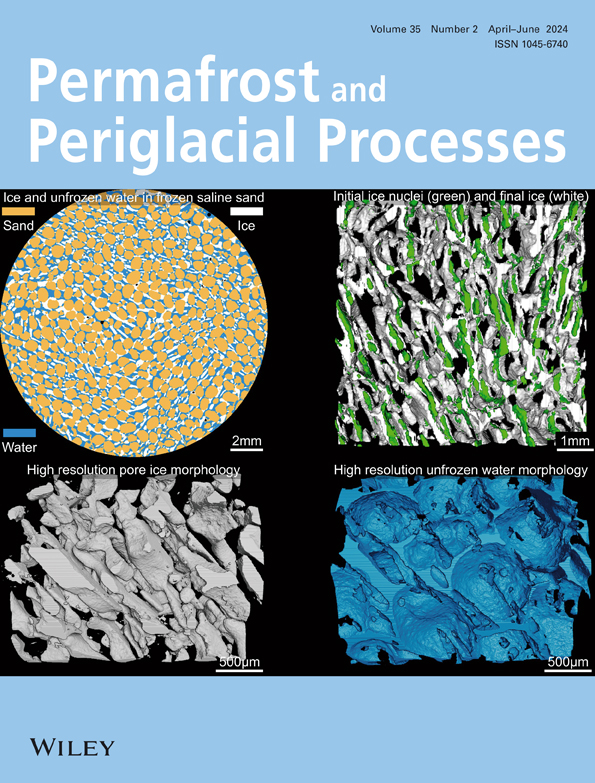Near‐surface geophysical imaging of a thermokarst pond in the discontinuous permafrost zone in Nunavik (Québec), Canada
IF 3.3
3区 地球科学
Q2 GEOGRAPHY, PHYSICAL
引用次数: 0
Abstract
In this study, high resolution ground‐penetrating radar (GPR), electrical resistivity tomography (ERT), and spectral‐induced polarization tomography (SIPT) were used to (i) delineate characteristic solifluction features, (ii) map the ice distribution, and (iii) assess subsurface water content and permeability in the surrounding rampart of a thermokarst pond in the discontinuous permafrost zone. The study site is located in the Tasiapik Valley near Umiujaq in Nunavik (Québec), Canada, which benefits from decades of geological mapping, geophysical investigation, and monitoring of ground temperature and thaw subsidence, providing an extensive understanding of the cryohydrogeological context of the area. The results of geophysical investigation undertaken in this study were cross validated using core sampling, laboratory core analysis, and in situ ground temperature and water content monitoring. Based on this investigation, a conceptual model was derived and compared to the stratigraphy of cross‐section described in literature in finer‐grained context. Very good consistency was found from one in situ geophysical survey to another, as well as between the derived stratigraphic models and the ground truth. The combination of all the available data allowed the development of a detailed cryohydrogeological model across the studied thermokarst pond, which highlights the effect of lithology, topography, and land cover on the distribution and mobility of water in the ground.加拿大努纳维克(魁北克)不连续永久冻土带热岩溶池塘的近地表地球物理成像
在这项研究中,高分辨率探地雷达(GPR)、电阻率层析成像(ERT)和光谱诱导偏振层析成像(SIPT)被用于(i)描绘特征的自波动特征,(ii)绘制冰的分布图,以及(iii)评估不连续永久冻土带中的热岩溶池塘的周围斜坡中的地下含水量和渗透性。该研究地点位于加拿大努纳维克(魁北克)Umiujaq附近的Tasiapik山谷,得益于数十年的地质测绘、地球物理调查以及对地面温度和解冻沉降的监测,使人们对该地区的低温水文地质背景有了广泛的了解。本研究中进行的地球物理调查结果通过岩心取样、实验室岩心分析以及现场地面温度和含水量监测进行了交叉验证。基于这一调查,导出了一个概念模型,并将其与文献中描述的细粒度背景下的横断面地层学进行了比较。从一次现场地球物理调查到另一次,以及推导出的地层模型和地面实况之间都发现了非常好的一致性。所有可用数据的结合使得能够在所研究的热岩溶池塘中开发详细的低温水文地质模型,该模型突出了岩性、地形和土地覆盖对地下水分布和流动的影响。
本文章由计算机程序翻译,如有差异,请以英文原文为准。
求助全文
约1分钟内获得全文
求助全文
来源期刊
CiteScore
9.70
自引率
8.00%
发文量
43
审稿时长
>12 weeks
期刊介绍:
Permafrost and Periglacial Processes is an international journal dedicated to the rapid publication of scientific and technical papers concerned with earth surface cryogenic processes, landforms and sediments present in a variety of (Sub) Arctic, Antarctic and High Mountain environments. It provides an efficient vehicle of communication amongst those with an interest in the cold, non-glacial geosciences. The focus is on (1) original research based on geomorphological, hydrological, sedimentological, geotechnical and engineering aspects of these areas and (2) original research carried out upon relict features where the objective has been to reconstruct the nature of the processes and/or palaeoenvironments which gave rise to these features, as opposed to purely stratigraphical considerations. The journal also publishes short communications, reviews, discussions and book reviews. The high scientific standard, interdisciplinary character and worldwide representation of PPP are maintained by regional editorial support and a rigorous refereeing system.

 求助内容:
求助内容: 应助结果提醒方式:
应助结果提醒方式:


